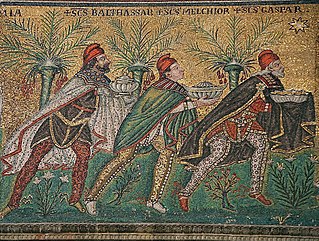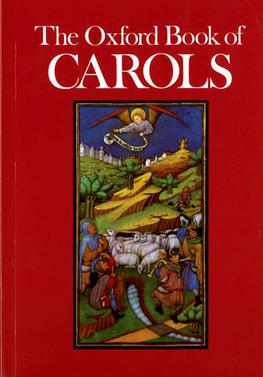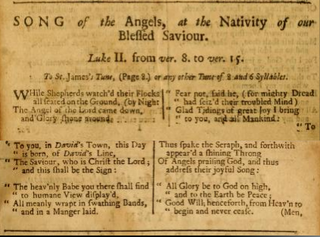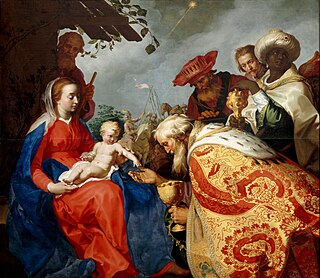Related Research Articles

A Christmas carol is a carol (a song or hymn) on the theme of Christmas, traditionally sung at Christmas itself or during the surrounding Christmas and holiday season. The term noel has sometimes been used, especially for carols of French origin. Christmas carols may be regarded as a subset of the broader category of Christmas music.

In Christianity, the Biblical Magi, also known as the Three Wise Men, Three Kings, and Three Magi, are distinguished foreigners who visit Jesus after his birth, bearing gifts of gold, frankincense, and myrrh in homage to him. They are commemorated on the feast day of Epiphany—sometimes called "Three Kings Day"—and commonly appear in the nativity celebrations of Christmas.
"Joy to the World" is an English hymn and Christmas carol. It was written in 1719 by the English minister and hymnist Isaac Watts. It is usually sung to the American composer Lowell Mason's 1848 arrangement of a tune attributed to George Frideric Handel. The hymn's lyrics are a Christian reinterpretation of Psalm 98 and Genesis 3.

Epiphany, also known as "Theophany" in Eastern Christian tradition, is a Christian feast day commemorating the visit of the Magi, the baptism of Jesus, and the wedding at Cana.

"We Three Kings", original title "Three Kings of Orient", also known as "We Three Kings of Orient Are" or "The Quest of the Magi", is a Christmas carol that was written by John Henry Hopkins Jr. in 1857. At the time of composing the carol, Hopkins served as the rector of Christ Episcopal Church in Williamsport, Pennsylvania, and he wrote the carol for a Christmas pageant in New York City. It was the first widely popular Christmas carol written in America.
"O Come, All Ye Faithful", also known as "Adeste Fideles", is a Christmas carol that has been attributed to various authors, including John Francis Wade (1711–1786), John Reading (1645–1692), King John IV of Portugal (1604–1656), and anonymous Cistercian monks. The earliest printed version is in a book published by Wade. A manuscript by Wade, dating to 1751, is held by Stonyhurst College in Lancashire.

"Christ the Lord Is Risen Today" is a Christian hymn associated with Easter. Most of the stanzas were written by Charles Wesley, and the hymn appeared under the title "Hymn for Easter Day" in Hymns and Sacred Poems by Charles and John Wesley in 1739. The hymn eventually became well known for the "Alleluia" sung as a melisma after each line, which was added by an unknown author, probably to fit the commonly used hymn tune, "Easter Hymn". It remains a traditional processional hymn on Easter Sunday.

"What Child Is This?" is a Christmas carol with lyrics written by William Chatterton Dix in 1865 and set to the tune of "Greensleeves", a traditional English folk song, in 1871. Although written in Great Britain, the carol today is more popular in the United States than its country of origin.

William Chatterton Dix was an English writer of hymns and carols. He was born in Bristol, the son of John Dix, a local surgeon, who wrote The Life of Chatterton the poet, a book of Pen Pictures of Popular English Preachers and other works. His father gave him his middle name in honour of Thomas Chatterton, a poet about whom he had written a biography. He was educated at the Grammar School, Bristol, for a mercantile career, and became manager of a maritime insurance company in Glasgow where he spent most of his life.

"Angels We Have Heard on High" is a Christmas carol to the hymn tune "Gloria" from a traditional French song of unknown origin called "Les Anges dans nos campagnes", with paraphrased English lyrics by James Chadwick. The song's subject is the birth of Jesus Christ as narrated in the Gospel of Luke, specifically the scene outside Bethlehem in which shepherds encounter a multitude of angels singing and praising the newborn child.
"For the Beauty of the Earth" is a Christian hymn by Folliott S. Pierpoint (1835-1917).

The Oxford Book of Carols is a collection of vocal scores of Christmas carols and carols of other seasons. It was first published in 1928 by Oxford University Press and was edited by Percy Dearmer, Martin Shaw and Ralph Vaughan Williams. It became a widely used source of carols among choirs and church congregations in Britain.

"While shepherds watched their flocks" is a traditional Christmas carol describing the Annunciation to the Shepherds, with words attributed to Irish hymnist, lyricist and England's Poet Laureate Nahum Tate. It is listed as number 936 in the Roud Folk Song Index.

"The Three Kings", or "Three Kings From Persian Lands Afar", is a Christmas carol by the German composer Peter Cornelius. He set "Die Könige" for a vocal soloist, accompanied by Philip Nicolai's hymn "Wie schön leuchtet der Morgenstern", which he erroneously thought was an Epiphany hymn. In fact, it is an Advent hymn in which the morning star is an allegory for the arrival of Jesus, not the Star of Bethlehem. In Cornelius' original second setting, the accompaniment was played on a piano but the English organist Ivor Atkins later arranged the accompaniment for choir, with the choir singing the words of the original hymn. The German words have been translated into English by H.N. Bate. The carol describes the visit of the Biblical Magi to the Infant Jesus during the Nativity and is also used as an Epiphany anthem.

"Love Came Down at Christmas" is a Christmas poem by Christina Rossetti. It was first published without a title in Time Flies: A Reading Diary in 1885. It was later included in the collection Verses in 1893 under the title "Christmastide".

Henry Ramsden Bramley was an English clergyman and hymnologist perhaps best known for his collaborations with the composer Sir John Stainer. Along with earlier 19th-century composers such as William Sandys and John Mason Neale, Bramley and Stainer are credited with fuelling a Victorian revival of Christmas carols with their 1871 publication of Christmas Carols, New and Old, which popularised carols such as "The First Nowell", "God Rest You Merry, Gentlemen" and "The Holly and the Ivy".

"Come, Thou Long Expected Jesus" is a 1744 Advent and Christmas carol common in Protestant hymnals. The text was written by Charles Wesley. It is performed to one of several tunes, including "Stuttgart", "Hyfrydol", and "Cross of Jesus". The hymn is considered an enduring classic in Christian hymnody.
"The Rocking Carol", also known as "Little Jesus, Sweetly Sleep" and "Rocking", is an English Christmas carol by Percy Dearmer. It was translated from Czech in 1928 and is performed as a lullaby to the baby Jesus.

"Earth Has Many a Noble City" is a Christian Epiphany hymn originally written by the Roman poet Aurelius Clemens Prudentius and translated by the English clergyman Edward Caswall in 1849.
"Deep in the Darkness a Starlight is Gleaming" is a British Christian Epiphany hymn by Jan Berry. The hymn was written to reference to the Massacre of the Holy Innocents following the visit of the Biblical Magi to the baby Jesus.
References
- 1 2 3 4 5 6 Emmett Studwell, William (1995). The Christmas Carol Reader. Haworth Press. pp. 71–72. ISBN 1-56024-974-9.
- 1 2 Hymns Ancient and Modern Ltd (1989). The New English Hymnal. Canterbury Press. p. 47. ISBN 1853110027.
- ↑ "As With Gladness, Men of Old". Church of England. Archived from the original on 2018-01-01. Retrieved 2018-01-01.
- 1 2 3 4 5 6 Buenting, Ruth (1999). Gloria!: Letters from the Hymn Writers. CSS Publishing. p. 23. ISBN 0788015265.
- ↑ Morgan, Robert (2012). Then Sings My Soul Book 3: The Story of Our Songs: Drawing Strength from the Great Hymns of Our Faith. Thomas Nelson Inc. p. 101. ISBN 978-0849947131.
- 1 2 3 "As with gladness, men of old". Hymnary.org. Retrieved 2018-01-01.
- ↑ "As with gladness men of old" . The Canterbury Dictionary of Hymnology. Retrieved 2018-01-03.
- ↑ "As with gladness, men of old – Dix". Hyperion Records. 2015-04-21. Retrieved 2018-01-01.
- ↑ Studwell, William (1996). The National and Religious Song Reader: Patriotic, Traditional, and Sacred Songs from Around the World . Psychology Press. p. 115. ISBN 0789000997.
- ↑ "For sale: Mural filled historic church built in 1871. Price $1". CBC. Retrieved 2018-01-01.
- ↑ Maus, Cynthia (1977). Christ and the Fine Arts (revised ed.). Harper & Row. p. 91. ISBN 0060654724.
- ↑ Busby, Mattha (2017-12-31). "'Is that a terrorist?' Prince Philip makes joke about bearded bystander". The Guardian. Retrieved 2018-01-02.
- ↑ "As with gladness men of old; Hymn-anthem". Library of Congress. 1939-10-26. Retrieved 2018-01-01.
- ↑ Glover, Raymond (1995). The Hymnal 1982 companion, Part 1. Vol. 3. Church Hymnal Corp. p. 91. ISBN 9780898691436.
- ↑ Caldwell, S.L. (1875). The Service of Song for Baptist churches. New York: Sheldon & Company. p. 96. ISBN 978-1-333-32158-1.
- ↑ The Methodist Woman. Vol. 27. UMC Joint Commission on Education and Cultivation. 1995. p. 134.
- ↑ "As with Gladness - new-era". LDS. Retrieved 2018-01-01.
- ↑ The Harvard University Hymn Book. Harvard University Press. 1974. p. 463. ISBN 978-0-674-38000-4.
- ↑ Petersen, William (2005). The Complete Book of Hymns. Tyndale House Publishers, Inc. p. 205. ISBN 1414331401.